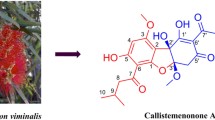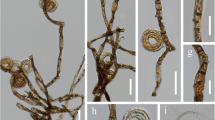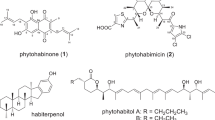Abstract
The endophytic fungus Chloridium sp. produces javanicin under liquid and solid media culture conditions. This highly functionalized naphthaquinone exhibits strong antibacterial activity against Pseudomonas spp., representing pathogens to both humans and plants. The compound was crystallized and the structure was elucidated by X-ray crystallography. The X-ray structure confirms the previously elucidated structure of the compound that was done under standard spectroscopic methods. The importance of javanicin in establishing symbiosis between Chloridium sp. and its host plant, Azadirachta indica, is briefly discussed.



Similar content being viewed by others
References
Altschul SF, Gish W, Miller W, Myers EW, Lipman DJ (1990) Basic local alignment search tool. J Mol Biol 215(3):403–410
Arnstein HRV, Cook AH (1947) Production of antibiotics by fungi Part III Javanicin an antibacterial pigment from Fusarium javanicum. J Chem Soc 1021–1027
Baker RA, Tatum JH, Nemec S Jr (1990) Antimicrobial activity of naphthoquinones from Fusaria. Mycopathologia 111:9–15
Bergeron D, Caron B, Brassard P (1993) An expeditious synthesis of Javanicin. J Org Chem 58:509–511
Brodey CL, Rainey PB, Tester M, Johnstone K (1991) Bacterial blotch disease of the cultivated mushroom is caused by an ion channel forming lipodepsipeptide toxin. Mol Plant Microbe Interact 4:407–411
Cardellina JH (1991) HPLC separation of taxol and cephalomannin. J Chromatogr 14:659–665
Van Eldere J (2003) Multicentre surveillance of Pseudomonas aeruginosa susceptibility patterns in nosocomial infections. J Antimicrob Chemother 51:347–352
Elkin S, Geddes D (2003) Pseudomonal infection in cystic fibrosis: the battle continues. Expert Rev Anti Infect Ther 1(4):609–618
Ezra D, Hess WM, Strobel GA (2004) New endophytic isolates of Muscodor albus, a volatile-antibiotic-producing fungus. Microbiology 150:4023–4031
Gams W, Holubova-Jechova V (1976) Chloridium and some other dematiaceous hyphomycetes growing on decaying wood. Stud Mycol Baarn 13:1–99
Gatenbeck S, Bentley R (1965) Naphthaquinone biosynthesis I moulds: the mechanism for formation of javanicin. Biochem J 94:478–481
Gunatilaka AAL (2006) Natural products from plant-associated microorganisms: distribution, structural diversity, bioactivity and implications of their occurrence. J Nat Prod 69:509–526
Guo B, Wang Y, Sun X, Tang K (2008) Bioactive natural products from endophytes: a review. Appl Biochem Microbiol 44:136–142
Jiao P, Swenson DC, Gloer JB, Wicklow DT (2006) Chloriolide, a 12-membered macrolide from Chloridium virescens var. chlamydosporum (NRRL 37636). J Nat Prod 69:636–639
Kim YJ, Nishida H, Pang CH et al (2002) CJ-21, 164, a New D-glucose-6-phosphate phosphohydrolase inhibitor produced by a fungus Chloridium sp. J Antibiot 55:121–127
Kimura Y, Takasm H, Nakazim H (1981) Isolation, identification and biological activities of 8-o-mythyle javanicin produced by Fusarium solani. Agric Biol Chem 45:2653–2654
Li GH, Yu ZF, Li X, Wang XB, Zheng LJ, Zhang KQ (2007) Nematicidal metabolites produced by the endophytic fungus Geotrichum sp. AL4. Chem Biodivers 4:1520–1524
Mahesh B, Tejesvi MV, Nalini MS et al (2005) Endophytic mycoflora of inner bark of Azadirachta indica A. Juss. Curr Sci 88:218–219
McGowan JE (2006) Resistance in nonfermenting gram-negative bacteria: multidrug resistance to maximum. Am J Med 119:S62–S70
Medentsev A, Arinbasarova AY, Akimenko VK (2005) Biosynthesis of naphthoquinone pigments by fungi of the genus Fusarium. Appl Biochem Microbiol 41:503–507
Rajagopal R, Suryanarayanan TS (2000) Isolation of endophytic fungi from leaves of neem (Azadirachta indica). Curr Sci 78:1375–1378
Schulz B, Boyal C (2005) The endophytic continuum. Mycol Res 109:661–686
Strobel G, Daisy B, Castillo U, Harper J (2004) Natural products from endophytic microorganisms. J Nat Prod 67:257–268
Tan RX, Zau WX (2001) Endophytes: a rich source of functional metabolites. Nat Prod Rep 18:448–459
Veitch GE, Beckmann E, Burke BJ, Boyer A, Ayats C, Ley SV (2007) A relay route for the synthesis of azadirachtin. Angew Chem Int Ed 46:7633–7635
Veitch GE, Beckmann E, Burke BJ, Boyer A, Ayats C, Ley SV (2007) Synthesis of azadirachtin: a long but successful journey. Angew Chem Int Ed 46:7629–7632
Verma VC, Gond SK, Kumar A, Kharwar RN, Strobel GA (2007) Endophytic mycoflora of leaf stem and bark tissues of Azadirachta indica A. Juss, from Varanasi India. Microb Ecol 54:119–125
Wu SH, Chen YW, Shao SC et al (2008) Ten-membered lactones from Phomopsis sp., an endophytic fungus of Azadirachta indica. J Nat Prod 71(4):731–734
Acknowledgments
One of the authors (R.N.K.) is thankful to the Department of Science and Technology, New Delhi, for award of a “BOYSCAST fellowship” [(SR/BY/L-02/06) 2006-2007] to study at MSU. Support from the NSF, a Howard Hughes professorship to Scott Strobel at Yale University, and the Montana Agricultural Experiment Station are also acknowledged. We thank Dr T.T. Lam at the W.M. Keck Foundation Biotechnology Laboratory at Yale University for the FT-ICR MS analyses. Financial support to other authors (R.N.K., V.C.V., S.K.G., A.K.) from CSIR and UGC is gratefully acknowledged.
Author information
Authors and Affiliations
Corresponding author
Rights and permissions
About this article
Cite this article
Kharwar, R.N., Verma, V.C., Kumar, A. et al. Javanicin, an Antibacterial Naphthaquinone from an Endophytic Fungus of Neem, Chloridium sp.. Curr Microbiol 58, 233–238 (2009). https://doi.org/10.1007/s00284-008-9313-7
Received:
Revised:
Accepted:
Published:
Issue Date:
DOI: https://doi.org/10.1007/s00284-008-9313-7




